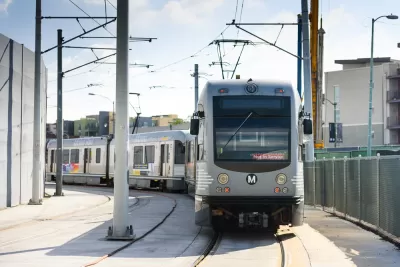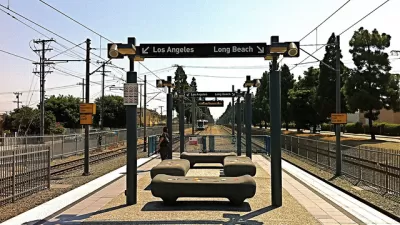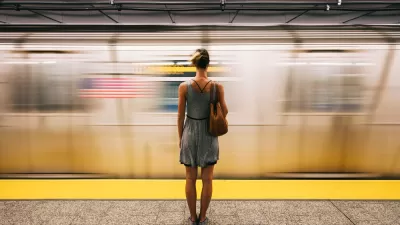Already delayed, the Crenshaw Line has now sparked debate between stakeholders who favor opposing visions of how the light rail service should link up with the existing Green Line.

Now expected to open in the summer of 2020, L.A.'s Crenshaw Line is set to intersect with the Green Line, which runs primarily east-west along the 105 Freeway. But a section of the Green Line also runs past LAX and south to Redondo Beach, and elected representatives for that area are concerned about Metro's favored option for managing the connection.
That plan, Laura J. Nelson writes, "would break the Green Line into two pieces at Aviation Boulevard. Riders along the portion of the line that runs along the 105 would be able to board a train every six minutes during peak periods and ride west and north to the Expo Line without transferring. But riders going to or coming from the South Bay's four Green Line stations, the portion of the line with the lowest ridership, would lose their one-seat ride."
Those riders, who account for only 12 percent of the Green Line's ridership, would be forced to "transfer from the Green Line to the Green Line," as Los Angeles County Supervisor Janice Hahn put it. Her district includes Redondo Beach.
But an alternative plan to preserve South Bay riders' one-seat trip would essentially oblige the new Crenshaw Line to run two-car trains, even though it could handle three-car ones, due to the older Green Line's electrical limitations. Metro's directors will decide the issue at a board meeting on December 6. Ultimately, a planned extension of the Green Line to Torrance in the mid-2020s will change the math here once again.
FULL STORY: Westside and South Bay clash over how to connect two rail lines

Alabama: Trump Terminates Settlements for Black Communities Harmed By Raw Sewage
Trump deemed the landmark civil rights agreement “illegal DEI and environmental justice policy.”

Planetizen Federal Action Tracker
A weekly monitor of how Trump’s orders and actions are impacting planners and planning in America.

Why Should We Subsidize Public Transportation?
Many public transit agencies face financial stress due to rising costs, declining fare revenue, and declining subsidies. Transit advocates must provide a strong business case for increasing public transit funding.

Understanding Road Diets
An explainer from Momentum highlights the advantages of reducing vehicle lanes in favor of more bike, transit, and pedestrian infrastructure.

New California Law Regulates Warehouse Pollution
A new law tightens building and emissions regulations for large distribution warehouses to mitigate air pollution and traffic in surrounding communities.

Phoenix Announces Opening Date for Light Rail Extension
The South Central extension will connect South Phoenix to downtown and other major hubs starting on June 7.
Urban Design for Planners 1: Software Tools
This six-course series explores essential urban design concepts using open source software and equips planners with the tools they need to participate fully in the urban design process.
Planning for Universal Design
Learn the tools for implementing Universal Design in planning regulations.
Caltrans
Smith Gee Studio
Institute for Housing and Urban Development Studies (IHS)
City of Grandview
Harvard GSD Executive Education
Toledo-Lucas County Plan Commissions
Salt Lake City
NYU Wagner Graduate School of Public Service




























